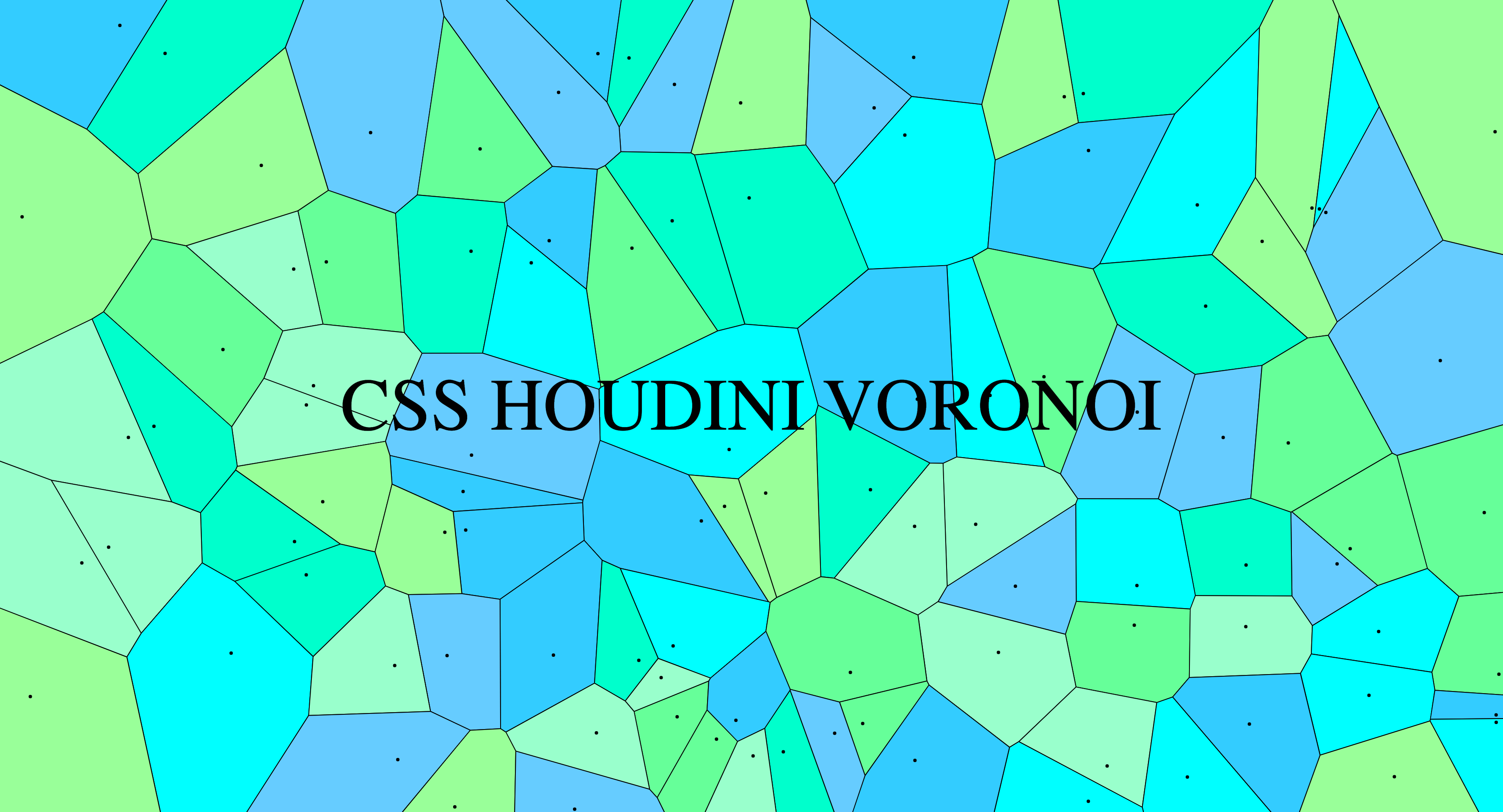README
CSS Houdini Voronoi
A CSS Houdini Paint Worklet that draws a Voronoi Diagram as a background image
 Demo: https://codepen.io/bramus/pen/mdrWrGm
Demo: https://codepen.io/bramus/pen/mdrWrGm
Usage
1. Getting css-houdini-voronoi
Using a pre-built hosted version
The easiest way to get css-houdini-voronoi is to use the prebuilt version through UNPKG. Just skip ahead to step 2 in that case.
Installing it Locally
You can install the css-houdini-voronoi locally using NPM.
npm install css-houdini-voronoi
Alternatively you can clone the css-houdini-voronoi repo and after manually build the project:
cd css-houdini-voronoi
npm install
npm run build
You'll find the built file in the ./dist folder.
2. Loading css-houdini-voronoi
To include it you must loads the module in the given JavaScript file and add it to the Paint Worklet.
If you want to use the UNPKG hosted version of css-houdini-voronoi, use https://unpkg.com/css-houdini-voronoi/dist/worklet.js as the moduleURL.
if ('paintWorklet' in CSS) {
CSS.paintWorklet.addModule('https://unpkg.com/css-houdini-voronoi/dist/worklet.js');
}
If you've installed css-houdini-voronoi using NPM or have manually built it, refer to its url:
if ('paintWorklet' in CSS) {
CSS.paintWorklet.addModule('url/to/worklet.js');
}
A note on older browsers
To add support for browsers that don't speak Houdini, you can include the css-paint-polyfill before loading the Worklet.
<script>
(async function() {
if (CSS['paintWorklet'] === undefined) {
await import('https://unpkg.com/css-paint-polyfill');
}
CSS.paintWorklet.addModule('https://unpkg.com/css-houdini-voronoi/dist/worklet.js');
})()
</script>
3. Applying css-houdini-voronoi
To use Voronoi Paint Worklet you need to set the background-image property to paint(voronoi)
.element {
background-image: paint(voronoi);
}
Configuration
You can tweak the appearance of the Paint Worklet by setting some CSS Custom Properties
| property | description | default value |
|---|---|---|
| --voronoi-number-of-cells | Number of cells, (integer or auto). When set to auto it will adjust itself the number of cells based on the available space. |
25 |
| --voronoi-margin | Margin to keep from edges, as a percentage (0% – 50%). Set to a negative value to create a zoom effect | 0% |
| --voronoi-line-color | Line Color | #000 |
| --voronoi-line-width | Line Width, in pixels | 3 |
| --voronoi-dot-color | Color of the dot in each cell | transparent |
| --voronoi-dot-size | Size of the dot in each cell, in pixels | 4 |
| --voronoi-cell-colors | Cell Colors, one or more colors to colorize the cells (comma separated). Set to transparent to not colorize the cells | #66ccff, #99ffcc, #00ffcc, #33ccff, #99ff99, #66ff99, #00ffff |
| --voronoi-seed | Seed for the "predictable random" generator, See https://jakearchibald.com/2020/css-paint-predictably-random/ for details. | 123456 |
💡 The Worklet provides default values so defining them is not required
Example
.element {
--voronoi-number-of-cells: 100;
--voronoi-margin: 5%;
--voronoi-line-color: #000;
--voronoi-line-width: 4;
--voronoi-dot-color: rgba(0,0,0,0.2);
--voronoi-dot-size: 10;
--voronoi-cell-colors: #50514f, #f25f5c, #ffe066, #247ba0, #70c1b3;
--voronoi-seed: 654321;
background-image: paint(voronoi);
}
Registering the Voronoi Custom Properties
To properly animate the Voronoi Custom Properties and to make use of the built-in syntax validation you need to register the Custom Properties. Include this CSS Snippet to do so:
@property --voronoi-number-of-cells {
syntax: "<integer> | auto";
initial-value: 25;
inherits: false;
}
@property --voronoi-margin {
syntax: "<percentage>";
initial-value: 0%;
inherits: false;
}
@property --voronoi-line-color {
syntax: "<color>";
initial-value: #000;
inherits: false;
}
@property --voronoi-line-width {
syntax: "<integer>";
initial-value: 1;
inherits: false;
}
@property --voronoi-dot-color {
syntax: '<color>';
initial-value: transparent;
inherits: false;
}
@property --voronoi-dot-size {
syntax: '<integer>';
initial-value: 2;
inherits: false;
}
@property --voronoi-cell-colors {
syntax: '<color>#';
initial-value: #66ccff, #99ffcc, #00ffcc, #33ccff, #99ff99, #66ff99, #00ffff;
inherits: false;
}
@property --voronoi-seed {
syntax: '<number>';
initial-value: 123456;
inherits: true;
}
💡 Inclusion of this code snippet is not required, but recommended.
Demo / Development
You can play with a small demo on CodePen over at https://codepen.io/bramus/pen/mdrWrGm
If you've cloned the repo you can run npm run dev to launch the included demo.
Acknowledgements
The Voronoi Diagram is generated using a precompiled Javascript-Voronoi. It is included in the build. Further inspiration was gotten from this demo.
License
css-houdini-voronoi is released under the MIT public license. See the enclosed LICENSE for details.